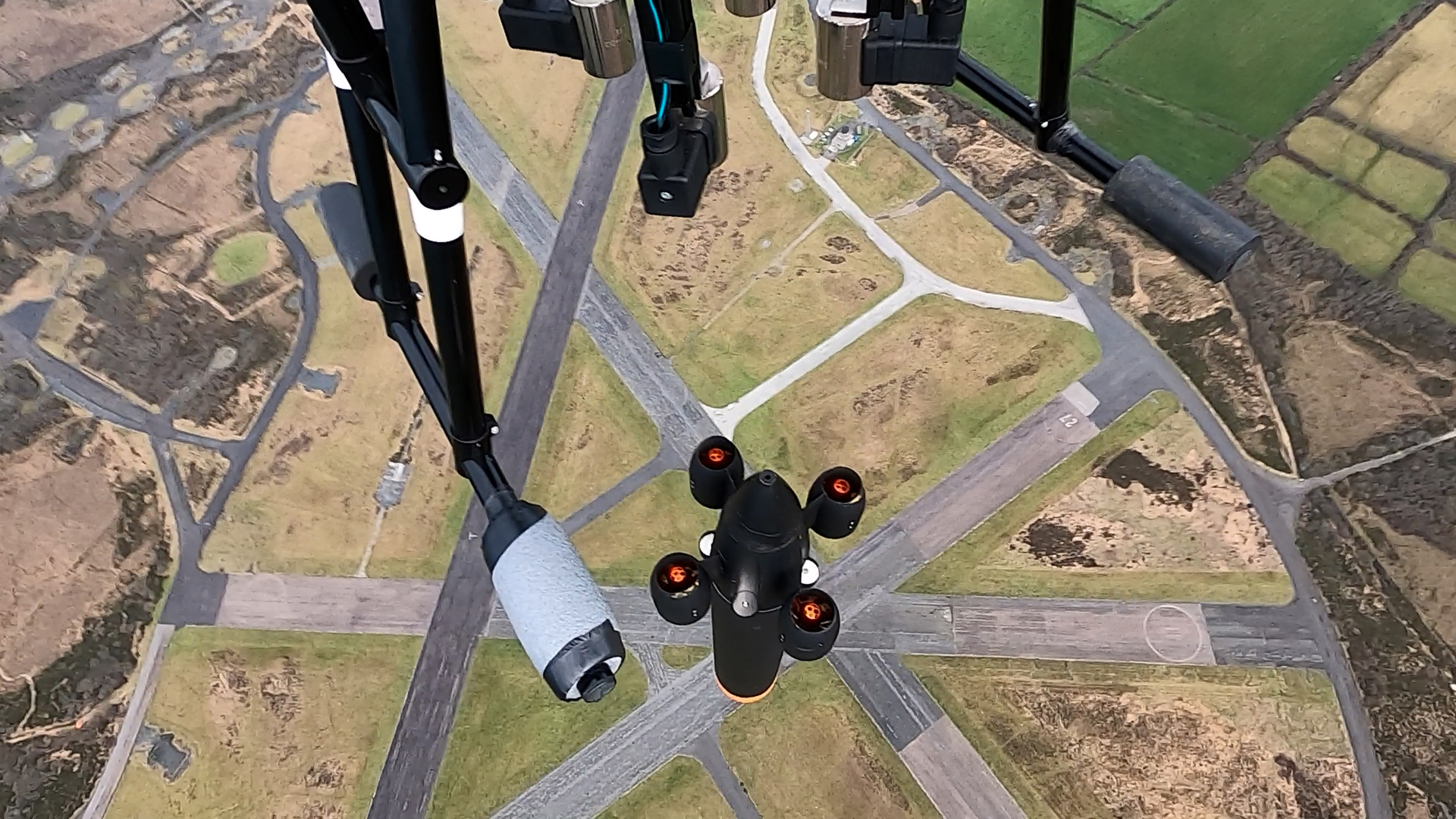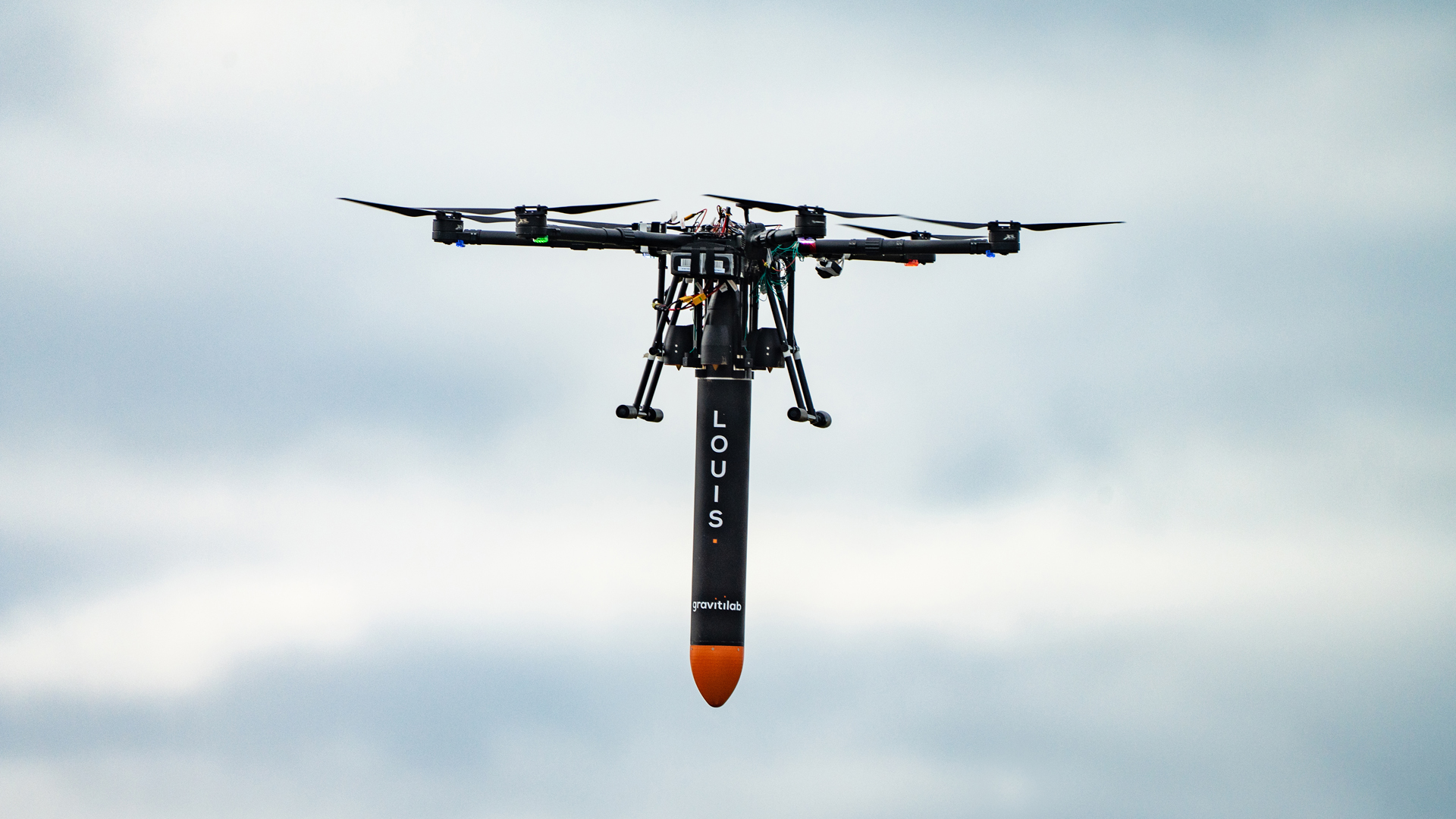Watch a drone drop a microgravity capsule in 1st-of-its-kind experiment (video)
Drones can create much longer microgravity flights than drop towers.
A British startup has performed a first-of-its-kind microgravity experiment using a drone.
The company, called Gravitilab, flew its adapted quadcopter to an altitude of 2,000 feet (600 meters), where it dropped a specially designed capsule carrying scientific experiments.
As the capsule fell toward the ground, its payload experienced over five seconds of weightlessness, which is much more than ground-based drop towers can achieve.
The company, operating from the Predannack military airfield in Cornwall in the southwest of England, plans to start commercial services providing microgravity flight opportunities that have not been available before.
"The only option for terrestrial microgravity testing [in Europe] until now has been to wait several years for access to a drop tower in Germany, which provides two seconds of microgravity," Rob Adlard, CEO and technical director of Gravitilab, said in an emailed statement. "Our service can be delivered locally, is less expensive and as a result of our demonstration flight, we are on target to offer 5 to 20 seconds of high-quality microgravity using our LOUIS UAV [unmanned aerial vehicle] system."
Related: Space flames and microgravity liquids: Astronauts mark 20 years with space station equipment

However, access to the International Space Station is expensive, and Earth-based simulations, including drop towers and parabolic fights on airplanes, are scarce. Gravitilab's technology is the first in the world taking advantage of unmanned aerial technology, company representatives said, and the firm believes it will "open the world of microgravity research to a new market."
Get the Space.com Newsletter
Breaking space news, the latest updates on rocket launches, skywatching events and more!
"Today's development is a step towards transforming testing across industries from cosmetics to satellites, enabling timely and cost-effective access to gravity-free environments," Gravitilab wrote in the statement.
The company is part of the Cornwall Space Cluster, one of the technology hubs the U.K. government and local authorities support with the aim of growing the country's stake in the global space business. Spaceport Cornwall — from which Virgin Orbit lifted off last month, on what was supposed to be the U.K.'s first orbital launch (the mission failed) — is also part of the endeavor.

"We're thrilled to have been able to support the achievement of this world first in microgravity testing from Cornwall," Gail Eastaugh, Cornwall Space Cluster's director, said in the statement. "Cornwall Space Cluster exists to unlock innovation within the space and aerospace sector, and companies like Gravitilab are paving the way for the future of the industry."
Gravitilab has developed its technology thanks to a U.K. Space Agency grant and is currently in discussions with new investors, the company wrote in the statement.
Blue Abyss, which is building "the world's largest swimming pool" for astronaut training and microgravity simulations underwater, is also a part of the cluster.
Follow Tereza Pultarova on Twitter @TerezaPultarova. Follow us on Twitter @Spacedotcom and on Facebook.
Join our Space Forums to keep talking space on the latest missions, night sky and more! And if you have a news tip, correction or comment, let us know at: community@space.com.

Tereza is a London-based science and technology journalist, aspiring fiction writer and amateur gymnast. Originally from Prague, the Czech Republic, she spent the first seven years of her career working as a reporter, script-writer and presenter for various TV programmes of the Czech Public Service Television. She later took a career break to pursue further education and added a Master's in Science from the International Space University, France, to her Bachelor's in Journalism and Master's in Cultural Anthropology from Prague's Charles University. She worked as a reporter at the Engineering and Technology magazine, freelanced for a range of publications including Live Science, Space.com, Professional Engineering, Via Satellite and Space News and served as a maternity cover science editor at the European Space Agency.
-
M Abrahamsson The article states that 5 seconds microgravity time is much more than in a drop tower.Reply
To my knowledge the ZARM drop tower can give almost 10 seconds in one mode.
(https://www.esa.int/Education/Drop_Your_Thesis/The_ZARM_drop_tower_in_Bremen)
Also, the article does not mention the possibility to launch on sounding rockets, which gives around 5 minutes of micorgravity conditions.
Now, I see this cool venture as a first step for researchers on their way to longer times on parabolic flights, sounding rockets or orbital platforms. -
CircuitBurner The UAV mentioned was not a "quad copter", it is clearly a hexarotor or an octorotor...6 or 8 rotors, not 4.Reply









